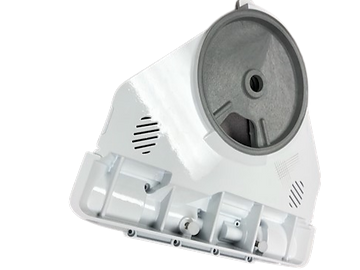Structural Foam Molding

What is Structural Foam Molding?
Structural foam molding is a low-pressure plastic injection molding process that produces thick, rigid parts. Structural foam parts have a porous foam core sandwiched between two solid outer layers. The foam core is accomplished by introducing inert gas such as Nitrogen, or a chemical blowing agent, to the melted resin during injection.
As a result of the process and high-performance resins used, structural foam plastics deliver high strength-to-weight, heat insulation, and electrical and acoustical properties. Structural foam molding is suitable for manufacturing medium to large sized parts in cosmetic and structural end-use applications.
How Does Structural Foam Molding Work?
In structural foam molding, the resin is injected into the mold cavity as a short shot. The addition of gas during injection expands and drags the melted resin throughout the mold until it is filled. Because the foam is doing the work, cavity pressure remains low — which translates into a low-stress part and lower clamp tonnage requirements.
Structural foam molding presses are similar to traditional injection molding machines, but larger in size and accompanied by a gas injection apparatus. Like standard injection molding, the Thermoplastic resin is fed by a hopper into a barrel and heating screw prior to injection. At this stage, structural foam molding takes on a life of its own with the introduction of inert gas or a blowing agent that produces CO2.
The inert gas, usually Nitrogen, is introduced to the melted resin just before injection. This gas expands within the mold cavity to aid plastic flow, thus requiring only a partial short-shot of resin. The foaming process and low pressure combine to fill the mold with plastic. Against the walls of the mold, the plastic cells freeze to develop a smooth, rigid outer skin on the part.
Once the cavity is filled the part begins to cool, the material in the core of the walls develops a porous cellular structure. The solid outer skin and porous interior give the part its strength and structural integrity.
Nominal wall thickness for structural foam parts ranges from 0.150-0.500 inches, with typical thickness being 0.250 inches. Due to the introduction of inert gas and internal cellular structure, structural foam parts can have 10-15% less density than traditional injection molded parts. This density reduction results in lower resin usage and costs.
Gas Assist, Gas Counter Pressure, and External Gas Molding
Gas assist, gas counter pressure, and external gas molding are complementary processes to structural foam molding. In these processes, specialized nozzles, inlets, and channels are incorporated into the part and tool design.
During injection, inert pressurized gas is introduced using a specialized nozzle or gas pin. With the resin shot completed, the pressurized gas continues to work. The gas controls the flow front and creates bubbles inside or around the part to manipulate the skin and resin throughout the mold cavity. Once the part has cooled to form a strong outer skin, the gas pressure is vented before the mold is opened and the part is ejected. Hollow sections can be achieved within a part using gas assist, gas counter pressure, and external gas.


Advantages of Structural Foam Molding
Structural foam molding offers many advantages, some of which include:
Low pressure, less stress on the part
Larger part size, shot sizes up to 200 lbs
High strength-to-weight ratio
Density and weight reduction up to 15% compared to traditional injection molding
Durability and impact resistance
Lower-cost, long-lasting Aluminum tooling
Ideal for structural and cosmetic applications
Dimensional accuracy and consistency
Structural Foam Molding Materials
Structural foam molding offers many advantages, some of which include:
Low pressure, less stress on the part
Larger part size, shot sizes up to 200 lbs
High strength-to-weight ratio
Density and weight reduction up to 15% compared to traditional injection molding
Durability and impact resistance
Lower-cost, long-lasting Aluminum tooling
Ideal for structural and cosmetic applications
Dimensional accuracy and consistency

Structural Foam Molding Applications
Structural foam molding is used in a wide range of industries and products. Some examples include:
Aerospace: Airframe and aircraft interiors, satellite components, large aviation enclosures
Construction: Large panels and parts, carts
Consumer: Structural containers, packaging, grill trays, wheelbarrows, speaker enclosures
Defense: Security screening equipment, EMI/RFI shielded enclosures
Energy: Metering equipment enclosures, smart grid components, fluid handling equipment
Industrial: Trash and recycling carts, agricultural equipment housings, reusable pallets, commercial floor washer covers, ATM enclosures
Medical: Mobile cart trays / bases / skins / handles, MRI and X-ray equipment panels / doors, diagnostic laboratory equipment enclosures, surgical arms
Technology: Electronic device housings, electronic storage enclosures, robotics
Transportation: Commercial vehicle parts, ATV bumpers, autonomous robot structurals
.png)





























